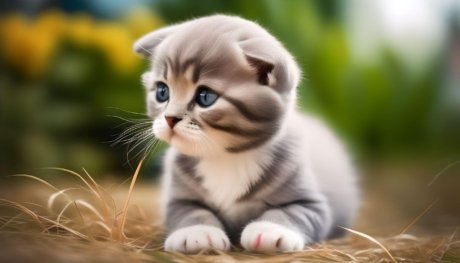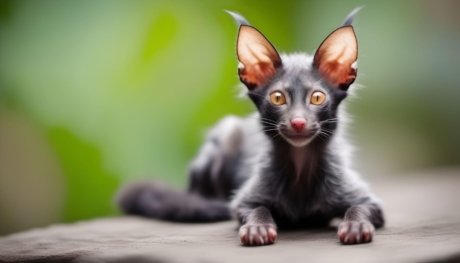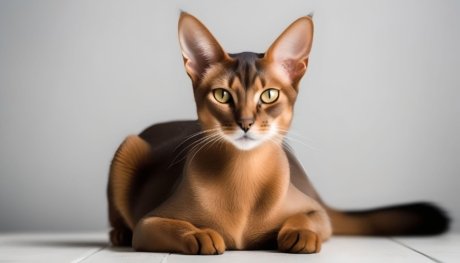Top 15 Hairless Cats Breed | Prices, Care Tips, Health Issues, Facts
Hairless cats are a captivating and unique breed that has piqued the curiosity and affection of cat lovers worldwide. These felines, known for their distinctive appearance and charming personalities, have been bred to highlight their lack of fur, making them stand out in the world of domestic pets. In this post, we’ll explore the fascinating world of hairless cats, from their origins and various breeds to their distinctive characteristics and how to care for them. Whether you’re considering adopting a hairless cat or simply want to learn more about these intriguing creatures, you’re in for an informative and engaging journey through the world of hairless cats.
Hairless Cat
Hairless cats, also known as Sphynx cats, are a unique and intriguing breed that has gained popularity among cat enthusiasts in recent years. These cats are known for their distinct lack of fur, which sets them apart from the typical furry feline companions we are used to. In this article, we will explore various aspects of hairless cats, including their history, characteristics, care requirements, and the appeal they hold for pet owners.

The history of hairless cats can be traced back to the 1960s in Canada, where the first known hairless cat, Prune, was born. The Sphynx breed, as we know it today, originated from this genetic anomaly. Sphynx cats are not completely hairless but have a fine downy layer of fuzz covering their bodies, giving them a unique and distinct appearance.
One of the most striking features of Sphynx cats is their wrinkled skin, which gives them a rather distinctive and alien-like appearance. These wrinkles are a natural part of their skin and are more pronounced in kittens, becoming less prominent as the cat matures. Sphynx cats come in a variety of colors and patterns, and their eyes can be any color.
While Sphynx cats lack a traditional fur coat, they require special care to keep their skin healthy. Due to their lack of fur, they are more susceptible to temperature changes, so it’s important to provide them with a warm environment and protect them from harsh weather conditions. Bathing is a crucial part of their grooming routine to remove excess oils from their skin. Additionally, regular sunscreen application is necessary to protect them from sunburn when they are outdoors.
Despite their unique appearance and care requirements, Sphynx cats are known for their affectionate and social nature. They are often described as being more dog-like in their behavior, forming strong bonds with their human companions. These cats enjoy attention and are known to be active and playful. They can be great companions for families and individuals looking for an interactive and engaging pet.

In terms of health, Sphynx cats may be prone to certain conditions due to their lack of fur. They are vulnerable to sunburn, skin infections, and can be more sensitive to extreme temperatures. It’s essential to keep a close eye on their health and provide regular veterinary care to ensure their well-being.
Hairless Cats Characteristics
Here are some key characteristics of hairless cats:
| Characteristic | Description |
|---|---|
| Coat | Hairless or with fine, downy fuzz |
| Skin Texture | Smooth and soft, with occasional wrinkles |
| Personality | Affectionate, playful, and social |
| Temperament | Friendly, intelligent, and interactive |
| Appearance | Striking and unique, with exposed skin and prominent ears |
| Grooming Needs | Regular bathing to remove excess oils and debris |
| Skin Care | Sensitive to temperature, requires protection from sun |
| Health Considerations | Prone to sunburn, skin infections, and temperature changes |
| Color and Patterns | Various colors and patterns depending on breed |
| Popularity | Gaining popularity among cat enthusiasts |
Hairless Cat Kittens
Hairless cat kittens are a joy to watch as they grow and develop. They are born with wrinkled skin, resembling tiny, delicate aliens. As they mature, their skin becomes smoother, showcasing the subtle beauty of their unique hairlessness. These kittens are known for their playful antics and charming vulnerability, endearing them to anyone fortunate enough to share their lives. With a natural curiosity and an engaging personality, hairless cat kittens become captivating companions as they transition into adulthood.

Cute Hairless Cats
The cuteness of hairless cats goes far beyond their lack of fur. It’s in the softness and suppleness of their skin, the delicate folds and wrinkles that give them character, and their large, expressive eyes that hold a world of emotion. The unique charm of cute hairless cats is rooted in their individuality and the way their personalities shine through. They are proof that beauty is not solely defined by fur, and their endearing presence often wins over hearts with their quirky and charming appeal.
Fat Hairless Cat
Hairless cats come in various body shapes, and some of them may lean towards the chubbier side. Their pudgy physique, covered in soft, velvety skin, makes them incredibly huggable. These fat hairless cats maintain their lovable personalities, proving that a little extra cushioning doesn’t detract from their playful and affectionate nature. They are a testament to the fact that beauty and charm transcend body size and shape.
Half Hairless Cat
Some cats exhibit partial hairlessness, with patches of fur on certain parts of their body while being completely hairless on others. This striking contrast results in a visually captivating appearance that is as unique as it is charming. The dual texture of their skin, with one part smooth and hairless and the other adorned with fur, creates an intriguing and eye-catching look that appeals to those who appreciate the unconventional in cat breeds.
Muscle Hairless Cat
Hairless cats often have well-defined muscles, which are more apparent due to their lack of fur. Their sleek and muscular physique, combined with their hairless skin, makes their body structure quite striking. Their athleticism and the definition of their features contribute to a visually impressive and distinctive look. These cats exude strength and elegance, making them fascinating pets for those who appreciate a physically impressive feline.
Ugly Hairless Cat
The notion of beauty is subjective, and while some may find hairless cats to be unique and attractive, others might consider them “ugly.” However, these cats often surprise skeptics with their personalities. Their endearing and affectionate nature, combined with their unusual appearance, quickly wins over hearts, proving that beauty goes beyond the surface. Hairless cats offer a chance to appreciate the beauty of individuality and uniqueness.
Calico Hairless Cat
Calico is a coat color pattern characterized by patches of black, white, and orange. When combined with a hairless coat, calico hairless cats have a striking and visually appealing contrast. The unique combination of a hairless body and calico coloring results in a feline companion that is not only captivating but also stands out as a distinct and rare breed. They are a living canvas of colors and patterns, adding a layer of visual intrigue to the hairless cat experience.
Buff Hairless Cat
Buff is a term used to describe a specific color variation in hairless cats. Buff hairless cats have a warm, pale orange or cream-colored skin, creating a soft and inviting appearance. Their gentle and affectionate personalities make them even more endearing. Buff hairless cats offer a soothing and visually pleasing presence, making them a unique and charming choice for cat enthusiasts.
Top 15 Hairless Cat Breeds
Hairless cats, also known as “naked” cats, are a unique and fascinating group of feline breeds known for their lack of fur. These breeds have garnered significant attention in recent years due to their distinctive appearance and engaging personalities. In this list, we’ll explore the top 15 hairless cat breeds, each with its own characteristics and charm.
1. Hairless Sphynx Cat:
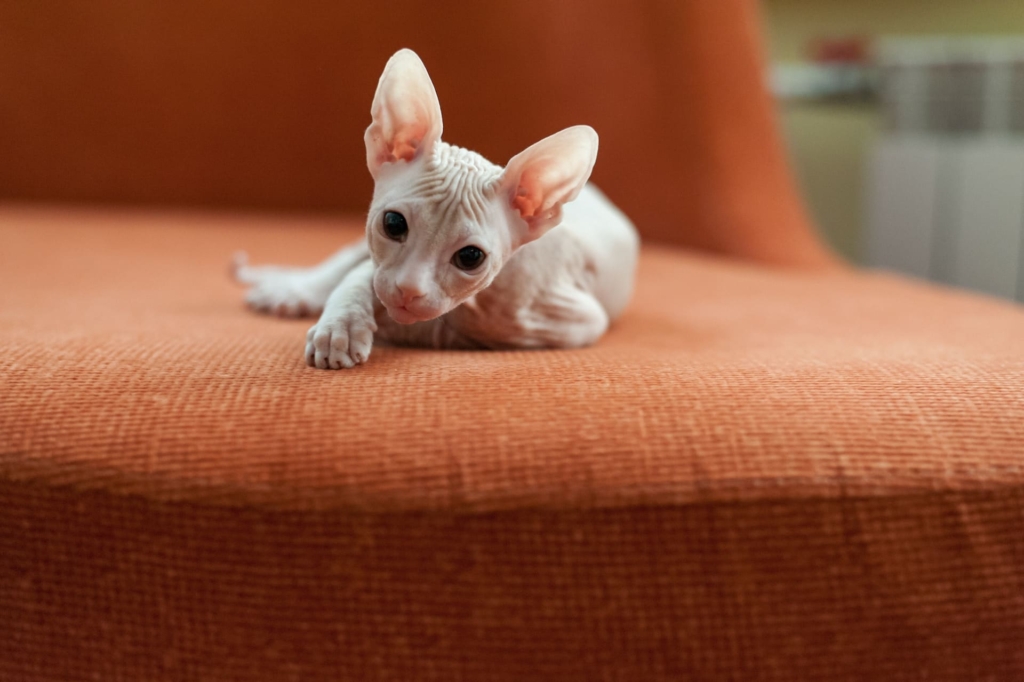
The Sphynx cat, arguably the most recognizable hairless breed, is renowned for its iconic wrinkled skin and large ears. These features give them a distinctive and elegant appearance. Sphynx cats are known for their active and playful personalities, forming strong bonds with their human companions. Their engaging and interactive nature, coupled with their unique look, makes them beloved pets for those who appreciate the extraordinary in feline companions.
- Behavior/Personality: Active, playful, engaging
- Temperament: Active and interactive
- Height: 8-10 inches (20-25 cm)
- Weight: 6-12 pounds (2.5-5.5 kg)
- Good Pet? Ideal for those who enjoy playful and interactive cats.
- Price:
- INR 20,000 – 40,000 (Approx.)
- USD 270 – 530 (Approx.)
2. Bambino Hairless Cat:

Bambino cats are a newer breed that combines the hairlessness of the Sphynx with the short legs of the Munchkin. The result is a unique and charming feline companion with a compact size, bald body, and playful personality. Bambinos enjoy attention and playtime, making them ideal for families and individuals seeking a one-of-a-kind pet.
- Behavior/Personality: Charming, playful, affectionate
- Temperament: Affectionate and playful
- Height: 7-9 inches (18-23 cm)
- Weight: 5-9 pounds (2-4 kg)
- Good Pet? Perfect for families and those seeking a unique pet.
- Price:
- INR 25,000 – 45,000 (Approx.)
- USD 330 – 600 (Approx.)
3. Donskoy Hairless Cat:
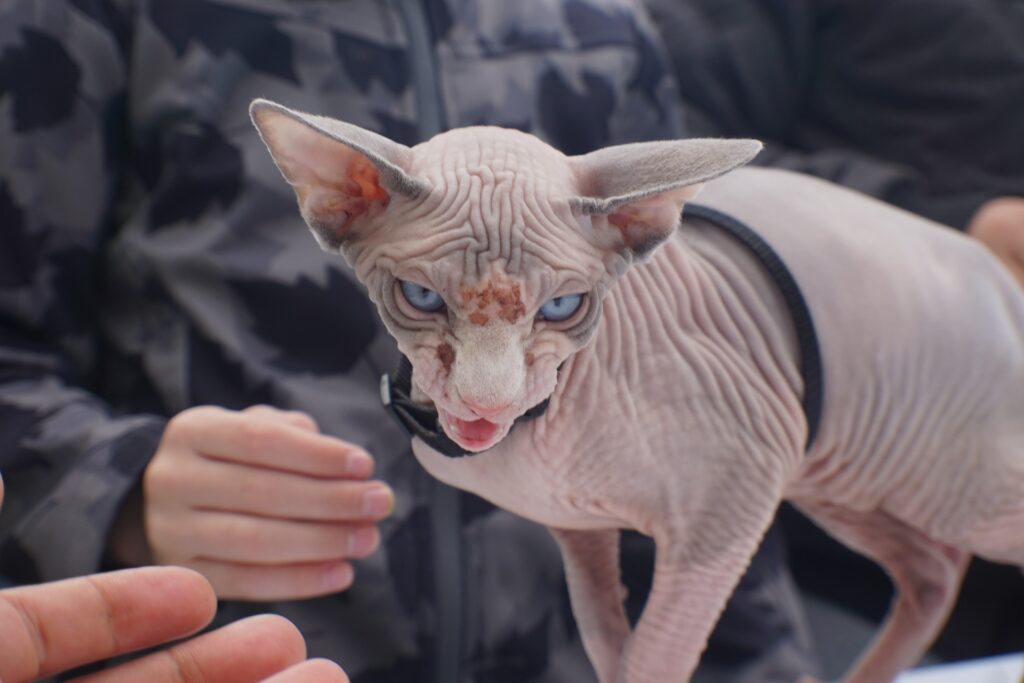
The Donskoy cat, also known as the Don Sphynx, hails from Russia. These cats possess a hairless coat, almond-shaped eyes, and an elegant disposition. They are sociable, affectionate, and intelligent, making them excellent companions for those who appreciate a more refined and loving feline friend.
- Behavior/Personality: Sociable, affectionate, intelligent
- Temperament: Sociable and intelligent
- Height: 8-10 inches (20-25 cm)
- Weight: 6-12 pounds (2.5-5.5 kg)
- Good Pet? Excellent for those who want a loving and refined feline friend.
- Price:
- INR 15,000 – 30,000 (Approx.)
- USD 200 – 400 (Approx.)
4. Peterbald Hairless Cat:
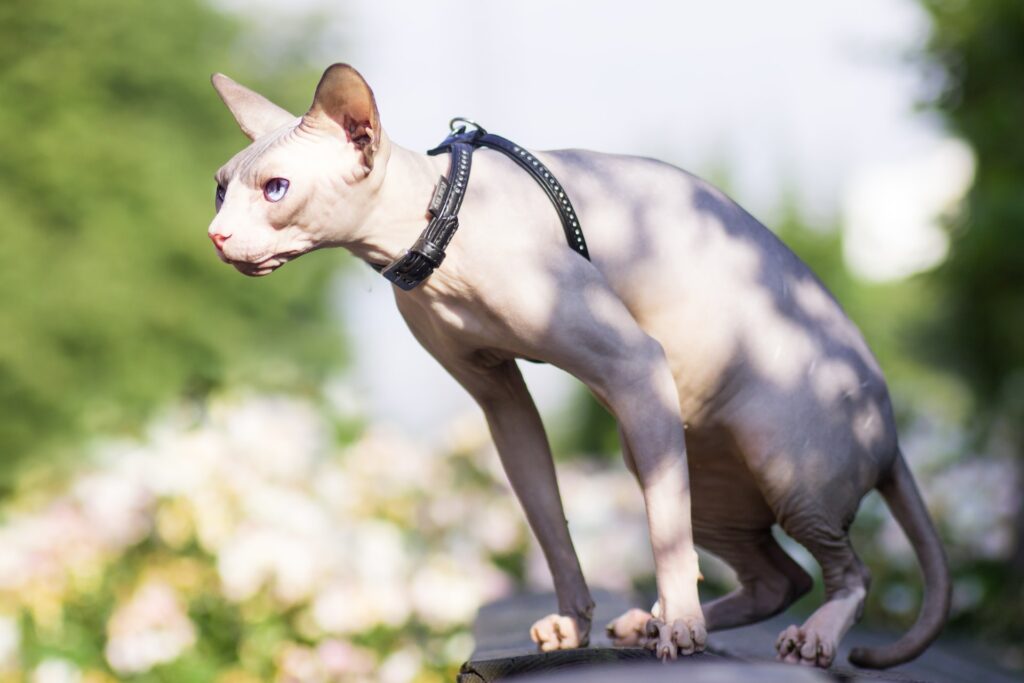
Another Russian breed, the Peterbald cat, is celebrated for its slender and elegant physique. What sets the Peterbald apart is its range of coat types, from completely bald to fine, downy fuzz. These cats are highly intelligent and develop strong bonds with their human family members.
- Behavior/Personality: Slender, elegant, intelligent
- Temperament: Intelligent and affectionate
- Height: 8-10 inches (20-25 cm)
- Weight: 6-12 pounds (2.5-5.5 kg)
- Good Pet? Great for those who appreciate an intelligent and affectionate cat.
- Price:
- INR 20,000 – 35,000 (Approx.)
- USD 270 – 470 (Approx.)
5. Elf Hairless Cat:

The Elf Cat, a relatively new and distinctive breed, is created by crossing the Sphynx and the American Curl. These cats have unique curled ears, a lack of fur, and an elf-like appearance. The combination of their hairlessness and ear curling gives them an enchanting and almost otherworldly look. Elf Cats are beloved by those who seek a truly unique and captivating feline companion, offering both visual and personality-based allure.
- Behavior/Personality: Unique, charming, playful
- Temperament: Charming and playful
- Height: 7-10 inches (18-25 cm)
- Weight: 5-10 pounds (2-4.5 kg)
- Good Pet? Ideal for those who seek a truly unique and captivating companion.
- Price:
- INR 30,000 – 50,000 (Approx.)
- USD 400 – 670 (Approx.)
6. Lykoi Hairless Cat:

Lykoi cats, often referred to as “werewolf cats,” are captivating due to their resemblance to mythical creatures. While they are not entirely hairless, they have patchy fur, creating a mysterious and intriguing appearance. Lykoi cats are known for their playful and affectionate nature, making them unique and endearing companions.
- Behavior/Personality: Playful, affectionate, intriguing
- Temperament: Playful and affectionate
- Height: 7-10 inches (18-25 cm)
- Weight: 5-10 pounds (2-4.5 kg)
- Good Pet? A unique and endearing companion.
- Price:
- INR 25,000 – 45,000 (Approx.)
- USD 330 – 600 (Approx.)
7. Canadian Sphynx Cat:
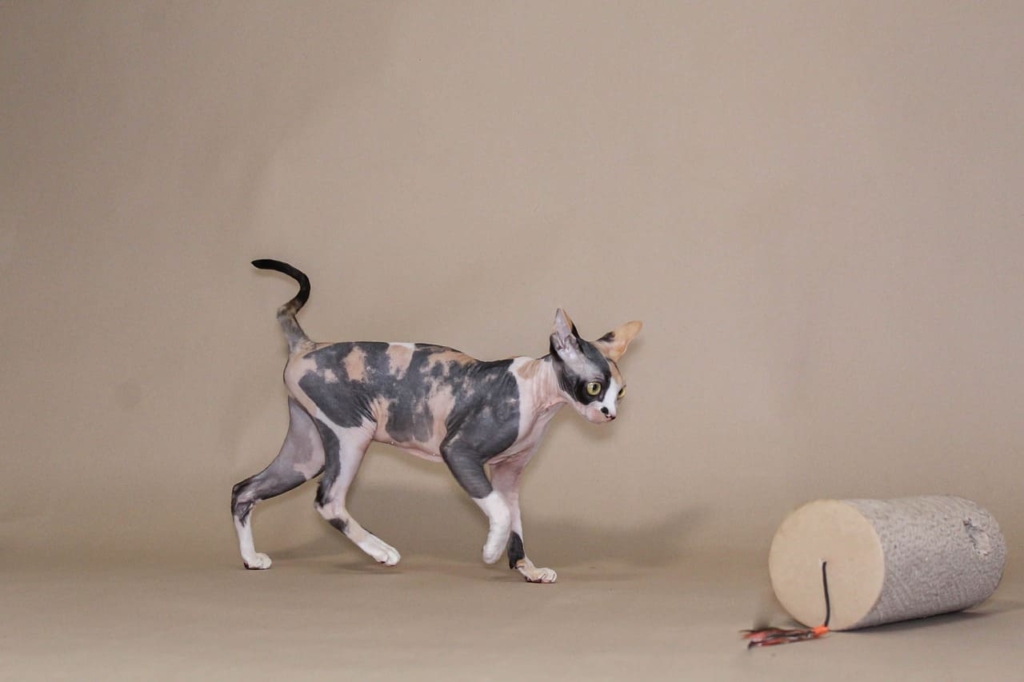
The Canadian Sphynx, distinct from the commonly known Sphynx, boasts a velvety coat and warm-to-the-touch skin. Their outgoing and friendly personalities make them wonderful additions to households seeking a combination of a hairless cat’s unique appearance and a sociable companion.
- Behavior/Personality: Outgoing, friendly, sociable
- Temperament: Sociable and outgoing
- Height: 8-10 inches (20-25 cm)
- Weight: 6-12 pounds (2.5-5.5 kg)
- Good Pet? Wonderful for those who want a unique, sociable companion.
- Price:
- INR 20,000 – 40,000 (Approx.)
- USD 270 – 530 (Approx.)
8. Cornish Rex Hairless Cat:
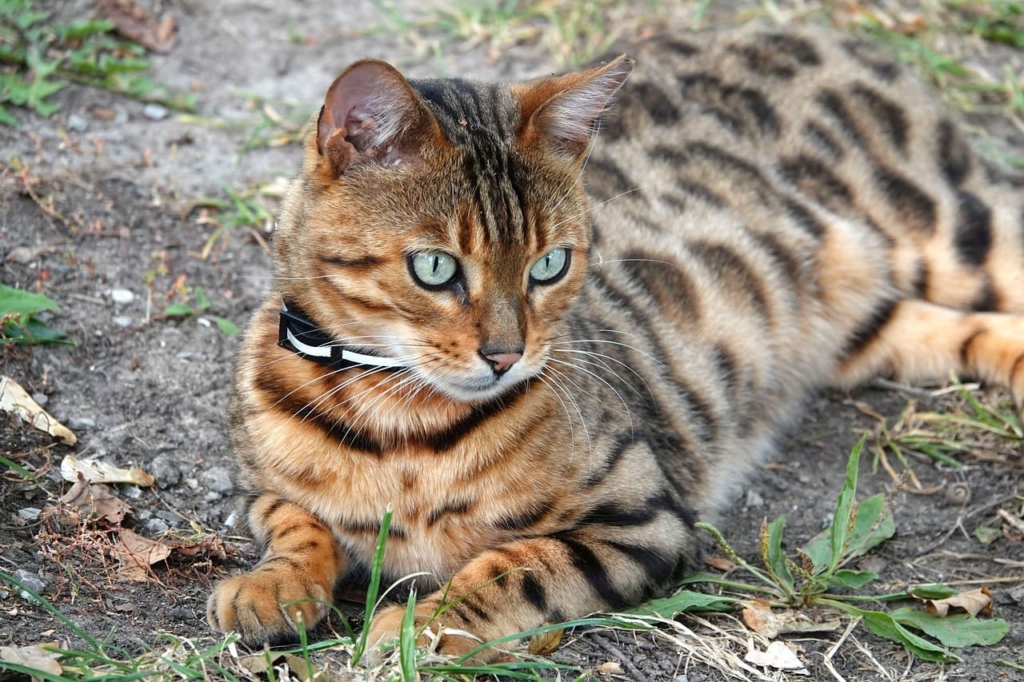
The Cornish Rex is not a hairless breed, but it has a very short, fine coat that gives it a nearly hairless appearance. These cats are known for their distinctive wavy fur, large ears, and playful nature. They are characterized by their active, intelligent, and entertaining personalities, making them beloved pets
- Behavior/Personality: Active, intelligent, entertaining
- Temperament: Active and entertaining
- Height: 8-10 inches (20-25 cm)
- Weight: 6-10 pounds (2.5-4.5 kg)
- Good Pet? Adored for their active, intelligent, and entertaining personalities.
- Price:
- INR 15,000 – 30,000 (Approx.)
- USD 200 – 400 (Approx.)
9. Hairless Siamese Cat:

The Hairless Siamese cat marries the striking characteristics of the Siamese breed with the unique feature of a hairless coat. Siamese cats are renowned for their piercing blue almond-shaped eyes and their color-pointed fur. When combined with a hairless coat, it creates an exceptional and graceful feline companion. Hairless Siamese cats embody elegance, intelligence, and vocal charm, making them an exquisite addition to any cat-loving household.
- Behavior/Personality: Elegant, intelligent, vocal
- Temperament: Intelligent and vocal
- Height: 7-9 inches (18-23 cm)
- Weight: 5-10 pounds (2-4.5 kg)
- Good Pet? Ideal for those who appreciate elegance and vocal charm.
- Price:
- INR 20,000 – 35,000 (Approx.)
- USD 270 – 470 (Approx.)
10. Egyptian Hairless Cat:

The Egyptian Hairless Cat, often known as the Egyptian Mau, is a breed that exudes the grace and mystique of ancient Egypt. Their sleek, exotic appearance pays homage to the revered cats of this historic civilization. These cats are a living embodiment of cultural heritage and elegance. They enchant with their unique beauty and charismatic demeanor, capturing the hearts of those who appreciate history, culture, and the allure of feline companions.
- Behavior/Personality: Graceful, charismatic, exotic
- Temperament: Charismatic and graceful
- Height: 8-10 inches (20-25 cm)
- Weight: 6-12 pounds (2.5-5.5 kg)
- Good Pet? Ideal for those who appreciate elegance and the allure of ancient Egypt.
- Price:
- INR 22,000 – 40,000 (Approx.)
- USD 300 – 530 (Approx.)
11. Persian Hairless Cat:

The Persian cat is traditionally associated with its long, luxurious fur. However, some Persian cats are born without traditional fur, resulting in hairless Persians. Despite their lack of fur, they maintain the same sweet and gentle temperament that the breed is known for. These unique felines offer the charm and companionship of Persians in a distinctive, hairless package, proving that beauty and grace extend beyond fur coats.
- Behavior/Personality: Sweet, gentle, affectionate
- Temperament: Sweet and gentle
- Height: 8-10 inches (20-25 cm)
- Weight: 6-12 pounds (2.5-5.5 kg)
- Good Pet? Offers the charm and companionship of Persians in a hairless package.
- Price:
- INR 25,000 – 45,000 (Approx.)
- USD 330 – 600 (Approx.)
12. Chinese Hairless Cat:

The Chinese Hairless Cat, or Chinese Crested Cat, is renowned for its hairless body adorned with tufts of fur on its head, tail, and paws. This unique combination of features creates a captivating and intriguing appearance. Their hairless skin, along with the contrasting tufts of fur, makes them a rare and extraordinary breed that stands out among other feline companions. Their distinct look, combined with their affectionate personalities, makes them unique and endearing pets.
- Behavior/Personality: Captivating, unique, affectionate
- Temperament: Captivating and affectionate
- Height: 7-10 inches (18-25 cm)
- Weight: 5-10 pounds (2-4.5 kg)
- Good Pet? Stands out among other feline companions with a unique and endearing personality.
- Price:
- INR 30,000 – 50,000 (Approx.)
- USD 400 – 670 (Approx.)
13. Hairless Munchkin Cat:
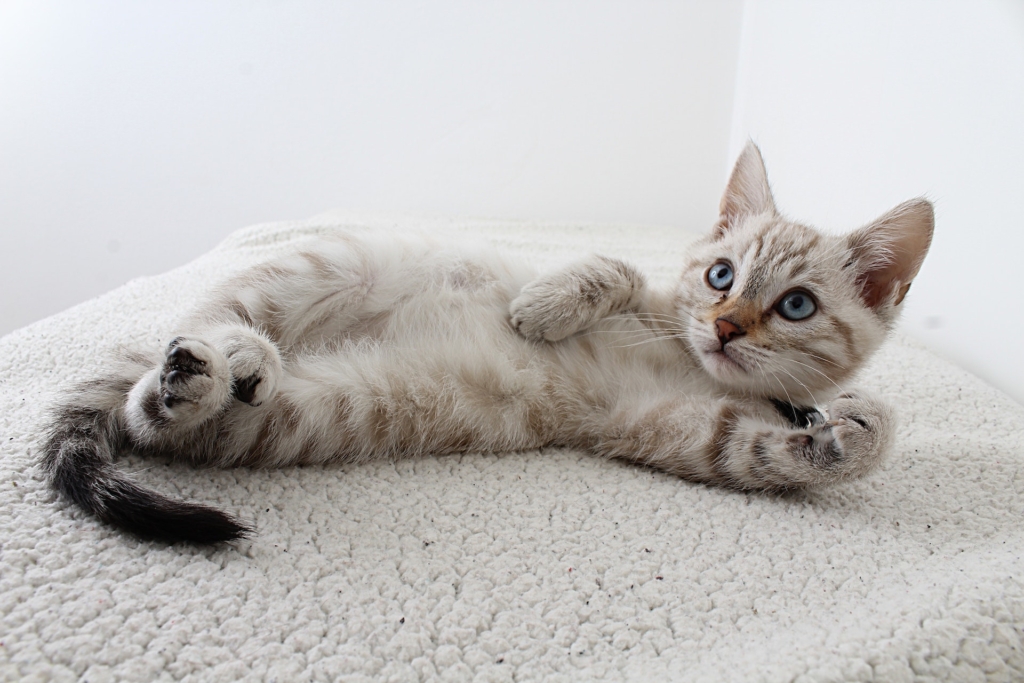
Munchkin cats are renowned for their short legs, which, when combined with a hairless coat, create an even more distinctive and charming breed. The visual contrast between their compact stature and their smooth, hairless skin adds to their overall appeal. Hairless Munchkin cats are not only visually intriguing but also known for their playful, mischievous, and affectionate nature. They offer a combination of characteristics that are both unique and adorable.
- Behavior/Personality: Distinctive, charming, playful
- Temperament: Charming and playful
- Height: 6-8 inches (15-20 cm)
- Weight: 5-8 pounds (2-3.5 kg)
- Good Pet? Offers a distinctive and adorable combination of characteristics.
- Price:
- INR 20,000 – 35,000 (Approx.)
- USD 270 – 470 (Approx.)
14. Mexican Hairless Cat:

Mexican Hairless Cats, known as Xoloitzcuintli or Xolos, have a history that spans centuries, making them a cherished part of Mexican culture. Their hairless appearance reflects their ancient lineage and cultural significance. These cats embody a rich heritage and a unique look, and they are treasured for their historical connection to Mexican traditions. Owning a Mexican Hairless Cat is like having a piece of history and culture as a beloved family member.
- Behavior/Personality: Rich heritage, unique, endearing
- Temperament: Unique and endearing
- Height: 10-12 inches (25-30 cm)
- Weight: 10-18 pounds (4.5-8 kg)
- Good Pet? A cherished part of Mexican culture with a rich heritage.
- Price:
- INR 18,000 – 35,000 (Approx.)
- USD 240 – 470 (Approx.)
15. Russian Hairless Cat:

Russian Hairless Cats, often referred to as Don Sphynx, are a rare breed known for their lack of fur. While they share some characteristics with the Sphynx, they have their own unique qualities. These cats have a mysterious and alluring quality that draws cat enthusiasts into their world. Russian Hairless Cats offer a fascinating combination of elegance and exotic charm that sets them apart.
- Behavior/Personality: Mysterious, alluring, exotic
- Temperament: Alluring and exotic
- Height: 8-10 inches (20-25 cm)
- Weight: 6-12 pounds (2.5-5.5 kg)
- Good Pet? Offers a fascinating combination of elegance and exotic charm.
- Price:
- INR 22,000 – 40,000 (Approx.)
- USD 300 – 530 (Approx.)
Hairless Cats Colour Variations
Hairless cats, known for their striking appearance, come in various color variations that add to their unique charm. Here are some of the most common color variations found in hairless cats:
Black Hairless Cat
Black hairless cats exude a sense of sleek and elegant beauty. Their velvety, jet-black skin is smooth and shiny, enhancing their unique hairless appearance. The contrast between their dark skin and often bright eyes is particularly striking, giving them an air of mystery and allure. Black hairless cats are like living statues, their form and beauty captivating all who have the privilege of sharing their lives.
Grey Hairless Cat
Grey hairless cats possess a cool and silvery-grey skin tone that adds a touch of sophistication to their hairless appearance. The gentle, muted coloration highlights their smooth and wrinkle-covered skin, creating a harmonious and aesthetically pleasing look. This color variation often complements their often expressive and intense eyes, enhancing the overall beauty of these feline companions.
Pink Hairless Cat
Pink hairless cats are known for their completely pink, or more accurately, flesh-colored skin. This unique and almost ethereal coloration showcases their hairlessness in a charming and endearing manner. The soft pink hue gives them a delicate and vulnerable appearance, emphasizing their distinctive and captivating features. Their bright, expressive eyes shine like jewels against the soft canvas of their skin.
Blue Hairless Cat
Blue hairless cats have a pale and cool-toned bluish-grey skin, setting them apart with an enchanting and almost ethereal presence. The combination of the cool skin tone and their often bright and vivid eyes creates a captivating and almost mystical look. Blue hairless cats are often associated with a sense of elegance and otherworldly charm, making them fascinating and captivating companions.
Brown Hairless Cat
Brown hairless cats exhibit a range of brown skin tones, from warm, earthy browns to deeper and richer shades. The brown coloration adds warmth and character to their hairless bodies, giving them a cozy and inviting presence. The smooth, brown skin accentuates the unique features of their breed, from wrinkles to large, expressive ears. These cats exude a sense of comfort and familiarity, making them endearing and cherished members of their human families.
History of Hairless Cat
The history of hairless cats dates back several decades, with the most well-known hairless breed, the Sphynx, having originated in the 1960s. However, hairless cats have been sporadically documented throughout history. The first recorded instances of naturally occurring hairless cats were in Mexico in the 1900s, but the breed didn’t become established until the Sphynx was developed in Canada in the 1960s. This breed was created through selective breeding, and it paved the way for the development of other hairless breeds.
Appearance of Hairless Cats
Hairless cats are known for their unique appearance. They lack the traditional fur coats seen in other breeds and instead have smooth, often wrinkled skin. Their skin can come in a variety of colors, and they typically have large ears, prominent cheekbones, and expressive eyes. Some hairless cats may have a fine, downy fuzz on their skin, while others are completely bald.

Temperament of Hairless Cat
Hairless cats are renowned for their affectionate and social nature. They tend to be outgoing and enjoy human interaction. They are known for forming strong bonds with their human companions and are often described as loving and cuddly. They have playful and mischievous personalities and thrive on attention.
Behaviour of Hairless Cat
Hairless cats exhibit a wide range of behaviors, much like other cat breeds. They are active and playful, often enjoying interactive toys and games with their owners. Some hairless cats may be more sensitive to temperature due to their lack of fur, so they may seek out warm spots or cozy blankets. They can also be quite vocal, expressing their needs and desires through meowing and purring.
What Are Hairless Cats Called
Hairless cats are often collectively referred to as “naked” cats. The term “naked” underscores their unique lack of fur, highlighting their distinct appearance. The Sphynx, Donskoy, and Peterbald are among the well-known breeds within this category.
Are Hairless Cats Hypoallergenic
While hairless cats are often believed to be hypoallergenic due to their lack of fur, they are not completely hypoallergenic. People with cat allergies are typically allergic to a protein found in a cat’s skin oils and saliva, not just the fur. Hairless cats still produce these allergenic proteins, so they can trigger allergies in some individuals, albeit potentially to a lesser extent than furry breeds.
Do Hairless Cats Poop On Walls
No, hairless cats do not have a particular inclination to poop on walls. Their bathroom behavior is similar to that of other cats. However, like any cat, they may have occasional accidents or litter box issues if not provided with a clean and appropriate place to relieve themselves. Proper litter box maintenance is essential for all cats, regardless of their breed or coat type.
Do Hairless Cats Have Whiskers
Yes, hairless cats have whiskers, just like other cat breeds. Whiskers, or vibrissae, serve as essential sensory organs for cats. They help them navigate their environment by sensing touch and changes in air currents. Whiskers are found on the muzzle, above the eyes, and on the backs of a cat’s front legs.
Why Are Sphynx Cats Hairless
Sphynx cats are hairless due to a natural genetic mutation. The mutation affects the production of hair, resulting in very fine or no fur. The breed was developed through selective breeding to retain this unique feature. Sphynx cats have been bred for their distinctive appearance, including their hairlessness, prominent ears, and wrinkled skin.
Are Hairless Cats Natural
Hairless cats are not entirely natural in the sense that they occur spontaneously in the wild. The most well-known hairless cat breeds, like the Sphynx, have been selectively bred to preserve their hairless characteristics. However, some instances of naturally occurring hairless cats have been documented in different parts of the world. These occurrences are relatively rare and have contributed to the development of hairless breeds through selective breeding.
Hairless Cat Price
In the USA, hairless cat prices typically range from $1,500 to $3,000 or more, with purebred and well-recognized breeds like the Sphynx often commanding higher prices. In India, the price of hairless cats can be more affordable, ranging from ₹20,000 to ₹60,000 or even lower for some mixed-breed or non-purebred hairless cats.
Hairless Cat Price in United States:
In the USA, the price of hairless cats can vary widely depending on breed and lineage. Generally, you can expect to pay anywhere from $1,500 to $3,000 or more for a purebred hairless cat, with well-recognized breeds like the Sphynx often commanding higher prices.
Hairless Cat Price in United Kingdom:
In the UK, the cost of hairless cats is somewhat similar to the USA. Purebred hairless cats typically range from £1,000 to £2,500 or more. However, it’s essential to note that prices can fluctuate based on factors such as breed popularity, breeder reputation, and the specific region.
Hairless Cat Price in Canada:
Hairless cat prices in Canada are comparable to those in the USA. You can anticipate paying between $1,500 and $3,000 or higher for a purebred hairless cat. The cost may also be influenced by the breeder’s reputation and the specific breed.
Hairless Cat Price in Australia:
In Australia, hairless cats are relatively rare, which can influence their price. Purebred hairless cats may range from $1,500 to $3,000 AUD or more. Due to the limited availability of hairless cats in the country, prices may vary, and prospective owners should carefully research breeders.
Hairless Cat Price in India:
Hairless cat prices in India tend to be more affordable compared to Western countries. The cost can range from ₹20,000 to ₹60,000 INR or even lower for some mixed-breed or non-purebred hairless cats. Prices may vary based on breed, lineage, and breeder reputation.
Hairless Cat Price in South Africa:
In South Africa, the price of hairless cats may vary. Generally, you can expect to pay around R5,000 to R10,000 ZAR for a purebred hairless cat. Prices can differ based on the breed and the breeder’s reputation.
Hairless Cat Prices with different Breeds In Major Indian and USA Cities
Here are Hairless Cat Prices with different Breeds In Major Indian and USA Cities:
| Breed | Major Indian Cities (Price Range in INR) | Major USA Cities (Price Range in USD) |
|---|---|---|
| Sphynx | ₹40,000 – ₹80,000 | $1,500 – $3,500 |
| Donskoy | ₹30,000 – ₹60,000 | $1,200 – $2,800 |
| Peterbald | ₹25,000 – ₹55,000 | $1,000 – $2,500 |
| Bambino | ₹35,000 – ₹70,000 | $1,500 – $3,200 |
| Ukrainian Levkoy | ₹30,000 – ₹60,000 | $1,200 – $2,800 |
| Elf Cat | ₹30,000 – ₹60,000 | $1,200 – $2,800 |
| Minskin | ₹30,000 – ₹60,000 | $1,200 – $2,800 |
| Bristol | ₹30,000 – ₹60,000 | $1,200 – $2,800 |
| Lykoi | ₹40,000 – ₹80,000 | $1,500 – $3,500 |
| Canadian Sphynx | ₹40,000 – ₹80,000 | $1,500 – $3,500 |
| Cornish Rex | ₹25,000 – ₹50,000 | $1,000 – $2,500 |
| Siamese Hairless | ₹35,000 – ₹70,000 | $1,500 – $3,200 |
| Egyptian Mau Hairless | ₹35,000 – ₹70,000 | $1,500 – $3,200 |
| Mexican Hairless (Xolo) | ₹20,000 – ₹45,000 | $800 – $2,000 |
Hairless Cat Breeders
Here are Top Breeders of Hairless Cats in different countries:
| Country | Association/Directories | Additional Resources |
|---|---|---|
| United States | – The International Cat Association (TICA) breeder directory | – Cat Fanciers’ Association (CFA) breeder referral |
| United Kingdom | – The Governing Council of the Cat Fancy (GCCF) breeder directory | – The Bengal Cat Club breeder directory |
| Canada | – The Canadian Cat Association (CCA) breeder directory | – The Canadian Kennel Club (CKC) breeder directory (Some breeders are also registered here) |
| Australia | – Cat Fanciers’ Association of Western Australia | – The Governing Council of the Cat Fancy (GCCF) |
| India | – Indian Cat Federation (ICF) breeder directory | – Online pet adoption platforms and classified websites |
Factors that Affect the Price of Hairless Cat
The price of a hairless cat can vary significantly based on several factors. Here are the key elements that affect the price of hairless cats:
- Breed: The specific breed of the hairless cat plays a significant role in determining its price. Breeds like the Sphynx, Donskoy, and Peterbald are well-known and often more expensive due to their distinct characteristics.
- Pedigree and Lineage: Cats with strong pedigrees and lineage with titles and awards from cat shows tend to be more expensive. These cats are often bred for specific desirable traits and are in high demand.
- Age: Kittens are generally more expensive than adult cats. Young kittens, especially those from champion bloodlines, can command a higher price.
- Health Screening: Reputable breeders conduct health screenings to ensure their cats are free from genetic disorders. Cats with a clean bill of health are often more expensive.
- Registration and Documentation: Cats that come with proper registration papers and documentation from recognized cat breed associations or clubs tend to have a higher price.
Monthly Maintenance Cost of Hairless Cats:
Owning a hairless cat comes with certain maintenance costs, including:
- Grooming: Despite their lack of fur, hairless cats require regular skin care, including bathing and moisturizing to keep their skin healthy and clean. Specialized cat-safe skincare products may be needed.
- Nutrition: High-quality cat food is essential for your hairless cat’s health. Some hairless cats have a higher metabolism and may need more food than other breeds.
- Veterinary Care: Regular check-ups, vaccinations, and preventive care are necessary. Some hairless cats may be more prone to skin issues or respiratory conditions, requiring additional veterinary attention.
- Temperature Control: Hairless cats are more sensitive to temperature changes. You may need to invest in heating or cooling systems to keep them comfortable.
- Litter and Supplies: Cat litter, litter boxes, toys, and other supplies are ongoing costs.
- Pet Insurance: Consider pet insurance to cover unexpected medical expenses.
- Hygiene Products: Skin-friendly shampoos and grooming products are essential for maintaining their skin health.
- Time and Attention: Hairless cats are social and thrive on human interaction, so providing them with time and attention is crucial for their well-being.
Facts about Hairless Cats
Here are some interesting facts about hairless cats:
- Not Truly Hairless: Hairless cats, such as the Sphynx, are not entirely hairless. They have a fine layer of downy fuzz on their skin, giving them a soft and almost suede-like texture.
- Natural Genetic Mutation: The hairlessness in Sphynx cats is the result of a natural genetic mutation. Breeders selectively bred cats with this trait to develop the Sphynx breed.
- Wrinkled Skin: Hairless cats often have wrinkled skin, which adds to their unique and endearing appearance. These wrinkles are most prominent around the neck and body.
- Unique Temperament: Hairless cats are known for their affectionate and sociable nature. They are often described as “dog-like” in their loyalty to their human companions.
- Higher Body Temperature: Hairless cats have a higher body temperature compared to furry breeds. They seek warmth and may enjoy cozy spots, blankets, or even cuddling to maintain their body heat.
- Regular Bathing: Due to the absence of fur, hairless cats require regular baths to remove oils and dirt from their skin. Special cat-friendly shampoos are used to keep their skin clean and healthy.
- Sun Sensitivity: Hairless cats are susceptible to sunburn, and their skin can be easily damaged by UV rays. It’s essential to protect them from direct sunlight.
- Prone to Skin Issues: Hairless cats may be more prone to skin conditions like rashes and fungal infections. Regular skin care and hygiene are crucial to their well-being.
- Vocal Communicators: Many hairless cats are known to be quite vocal, expressing their needs and desires through meowing and purring. They enjoy interacting with their human companions.
- Hypoallergenic Misconception: While some people assume hairless cats are hypoallergenic, they can still produce allergenic proteins found in their skin oils and saliva. People with cat allergies may react to hairless cats, though potentially to a lesser extent than furry breeds.
Pros and Cons of Hairless Cats
Here are some common pros and cons of owning hairless cats:
| Pros of Hairless Cats | Cons of Hairless Cats |
|---|---|
| Unique Appearance: Hairless cats have a distinctive and eye-catching look, often described as elegant and intriguing. | Sun Sensitivity: Hairless cats are prone to sunburn and require protection from direct sunlight. |
| Hypoallergenic Potential: Some people with cat allergies may find hairless cats to be a better option, as they produce fewer allergenic proteins found in cat fur. | Regular Bathing: Hairless cats require regular baths to keep their skin clean and healthy, which can be a time-consuming process. |
| Affectionate Nature: Hairless cats are known for their loving and cuddly personalities. They often form strong bonds with their human companions. | Skin Care: Hairless cats are more susceptible to skin conditions and require regular skin care, including moisturizing and protection. |
| Low Shedding: As they lack fur, hairless cats do not shed like furry breeds, reducing the amount of cat hair in your home. | Temperature Sensitivity: Hairless cats have a higher body temperature and are more sensitive to temperature changes. You may need to provide heating or cooling for their comfort. |
| Social and Playful: Hairless cats are social and enjoy human interaction. They are often described as “dog-like” in their loyalty. | Limited Breeds: Hairless cats are primarily represented by a few specific breeds, so you have limited options in terms of their appearance and characteristics. |
Hairless Cat Care
Caring for a hairless cat requires some specific considerations to ensure their health and well-being. Here are some essential aspects of hairless cat care:
- Skin Care: Hairless cats lack fur, which means their skin is exposed. Regular skin care is crucial to prevent issues like dryness and sunburn. Use cat-safe moisturizers and sunscreens as recommended by your veterinarian to protect their skin.
- Bathing: Hairless cats need regular baths to remove oil and dirt buildup on their skin. Use a cat-specific shampoo and warm water. Be gentle and ensure thorough rinsing.
- Temperature Regulation: Hairless cats are sensitive to temperature changes. Keep your home at a comfortable temperature, and provide them with warm spots or cozy blankets during colder seasons. In hot weather, ensure they have access to cool spaces.
- Sun Protection: Hairless cats are prone to sunburn. Limit their exposure to direct sunlight, and provide shade and protection when they are outdoors.
- Nutrition: Provide a high-quality cat food that meets their nutritional needs. Some hairless cats may have a higher metabolism and require more food. Consult with your veterinarian for dietary recommendations.
- Hydration: Ensure your cat has access to fresh water at all times. Hairless cats may require more water due to their increased body temperature.
- Veterinary Care: Schedule regular veterinary check-ups to monitor their overall health. Some hairless cats may be more susceptible to certain health issues, so early detection is essential.
- Grooming: Even though they lack fur, hairless cats may still have sweat and oil build-up on their skin. Wipe them down with a damp, clean cloth to maintain skin cleanliness between baths.
- Social Interaction: Hairless cats are known for their social and affectionate nature. Spend quality time with them, provide mental stimulation, and engage in interactive play to keep them happy and content.
- Litter Box: Ensure a clean and comfortable litter box. Hairless cats may be more sensitive to temperature, so keep the litter at a comfortable temperature for them.

Hairless Cat In Sweater
Hairless cats, such as Sphynx cats, are often seen wearing sweaters or clothing. This is not just a fashion statement but can serve a practical purpose. Hairless cats are more sensitive to temperature changes, and a sweater can help keep them warm and comfortable, especially in colder climates. Many cat owners enjoy dressing up their hairless cats in cute and stylish sweaters.
Funny Hairless Cat
Hairless cats have a unique and somewhat comical appearance, often described as funny and endearing. Their wrinkled skin, large ears, and expressive eyes can lead to amusing facial expressions and playful antics. Hairless cats are known for their entertaining behavior, making them a joy to have as pets.
Hairless Cat With Hair
While the term “hairless cat” typically refers to breeds like the Sphynx, there are instances of hairless cats being born with a very fine layer of fur, known as “down.” These cats are not truly hairless but have minimal, almost invisible fur. Such cats are rare and unique, and their fur is incredibly soft to the touch.
Allergic To Hairless Cats
Contrary to popular belief, some individuals can still be allergic to hairless cats. Allergies are often triggered by proteins in a cat’s skin oils and saliva rather than the fur itself. While hairless cats may produce fewer allergenic proteins, they are not entirely hypoallergenic, and people with severe cat allergies may still experience reactions.
Hairless Cat Tail
Hairless cats typically have long, slender tails that are in proportion to their body size. These tails are usually smooth and hairless, like the rest of their skin. Hairless cat tails are highly expressive and can convey the cat’s emotions through their movements and positions.
Pregnant Hairless Cat
If a hairless cat is pregnant, the care and attention she receives during pregnancy are crucial for the health of both the mother and her kittens. Pregnant hairless cats may have special needs, including a well-balanced diet, comfortable nesting areas, and regular veterinary check-ups to ensure a smooth pregnancy and delivery.
Hairless Cat Paw
Hairless cat paws are unique in appearance, with their soft and often wrinkled skin. Just like other cats, they have retractable claws that they use for various activities, such as climbing and scratching. Hairless cat paws are sensitive, and keeping them clean and healthy is essential for their well-being.
Health Issues of Hairless Cat
Hairless cats, like other breeds, are susceptible to certain health issues. While these cats are generally healthy, there are specific concerns that owners should be aware of. Here are some common health issues associated with hairless cats:
- Skin Conditions: Hairless cats are more prone to skin issues due to their lack of fur. Common skin problems include rashes, fungal infections, and sunburn. Regular skin care, including moisturizing and sun protection, is essential.
- Respiratory Issues: Some hairless cats may be more prone to respiratory infections. This is because they lack the protective barrier that fur provides, making them more susceptible to environmental allergens and temperature fluctuations.
- Hypothermia: Hairless cats have a higher body temperature than furry breeds. They are sensitive to cold temperatures and may become chilled easily. It’s essential to keep them warm in colder climates.
- Sunburn: Due to the absence of fur, hairless cats are susceptible to sunburn. Prolonged sun exposure can lead to skin damage. Protecting them from direct sunlight is crucial.
- Cardiomyopathy: Hairless cats, particularly the Sphynx breed, are known to be at risk of certain heart conditions, such as hypertrophic cardiomyopathy (HCM). Regular veterinary check-ups can help detect heart issues early.
Hairless Cat Lifespan
The lifespan of a hairless cat, like any other cat, can vary based on factors such as genetics, diet, overall care, and access to proper healthcare. On average, hairless cats tend to live for about 12 to 15 years. However, some hairless cat breeds, like the Sphynx, are known to have a slightly shorter lifespan, often falling within the 8 to 14-year range.
Food for Hairless Cats
Some common Food options for Hairless Cats:
| Food Type | Description |
|---|---|
| High-Quality Cat Food | Hairless cats require a balanced diet of commercial cat food that is rich in proteins, vitamins, and minerals. Look for cat food labeled “complete and balanced” to ensure they receive the necessary nutrients. |
| Moist Food | Wet cat food can help hairless cats maintain hydration due to their higher body temperature. It’s especially important if they don’t drink enough water on their own. |
| Specialized Cat Food | Some hairless cats may benefit from specialized cat food formulated for skin and coat health. These foods often contain omega-3 and omega-6 fatty acids. |
| Nutritional Supplements | Consult your veterinarian before providing any supplements. They may recommend supplements like omega-3 fatty acids to support skin health. |
| Avoid Human Food | Avoid feeding your hairless cat human food, as it may not meet their dietary needs and can lead to health issues. |
Hairless Cat Name
Some popular Names for Hairless Cats:
| Male Hairless Cat Names | Female Hairless Cat Names |
|---|---|
| Simba | Cleopatra |
| Gizmo | Sphynxie |
| Oliver | Bella |
| Loki | Luna |
| Mr. Bigglesworth | Nala |
| Gizmo | Pearl |
| Ziggy | Misty |
| Apollo | Gigi |
| Max | Noodle |
| Finnegan | Pippa |
Hairless Cat Video
Conclusion:
In conclusion, hairless cats, with their distinctive appearance and affectionate nature, have become beloved companions to many cat enthusiasts. These unique feline friends require specialized care and attention to ensure their well-being, particularly due to their sensitive skin and temperature needs. Whether it’s the elegant Sphynx or other hairless breeds, these cats have captured the hearts of those who appreciate their exceptional charm and endearing personalities.
Frequently Asked Questions on Hairless Cats:
-
Are hairless cats truly hairless?
No, hairless cats like the Sphynx have a fine layer of downy fuzz on their skin. They are not completely hairless.
-
Are hairless cats hypoallergenic?
While some people with cat allergies may tolerate hairless cats better, they are not entirely hypoallergenic. They can still produce allergenic proteins found in their skin oils and saliva.
-
How do I care for a hairless cat’s skin?
Regular skin care includes bathing with a cat-safe shampoo, moisturizing to prevent dryness, and protecting their skin from sunburn.
-
Do hairless cats get cold easily?
Yes, hairless cats are sensitive to cold temperatures and should be kept warm, especially in colder climates.
-
What are the common health issues in hairless cats?
Common health issues can include skin conditions, respiratory problems, and heart conditions. Regular vet check-ups are crucial.
-
What should I feed my hairless cat?
Feed your hairless cat high-quality cat food rich in proteins and essential nutrients. Wet cat food can help with hydration.
-
Can hairless cats go outside?
Hairless cats are sensitive to temperature and sunburn, so outdoor exposure should be limited. If they do go outside, it should be supervised and protected.
-
Are there different breeds of hairless cats?
Yes, there are various breeds, including the Sphynx, Donskoy, Peterbald, and more, each with unique characteristics.
-
Do hairless cats need special grooming?
Hairless cats may need regular baths, skin moisturizing, and skin inspections to maintain their skin health.
-
Are hairless cats good with children and other pets?
Hairless cats are known for their social nature and can be good with children and other pets. Proper introductions are essential.
Recommended –
- Scottish Fold Cat | Breed Profie, 6 Types, Prices, Care Tips, Facts, Health
- Lykoi Cat | Breed Profile, Prices, 5 Types, Care Tips, Facts, Health Issues
- Sphynx Cat | Breed Profile, Price, 8 Types, Care Tips, Facts, Health Issues
- Top 10 Cute Cats Breed (2023) : Adorable Felines That Melt Your Heart
- Top 7 Most Popular Cat Breeds, You Can Buy in – 2023
- Siamese Cat | Price, Breed Information, Expenses, Care Tips, Food, Health


























